This article is about a former rail operator in Australia. For a former rail operator in New Zealand, see Cityrail.
 The L7 logo of CityRail The L7 logo of CityRail | |
| Agency overview | |
|---|---|
| Formed | 16 January 1989 |
| Dissolved | 30 June 2013 |
| Superseding agencies | |
| Jurisdiction | New South Wales |
| Headquarters | Sydney |
| Parent agency | State Rail Authority (1989–2003) RailCorp (2004–2013) |
| Key document |
|
| Website | www.cityrail.info |
CityRail was a passenger railway brand operated by the State Rail Authority from 1989 to 2003 and by RailCorp from 2003 to 2013 with services in and around Sydney, Newcastle and Wollongong, the three largest cities in New South Wales, Australia. It was established in January 1989 and abolished in June 2013 when it was superseded by Sydney Trains and NSW TrainLink.
In June 2013, it operated 307 stations and over 2,060 kilometres of track, extending north to the upper Hunter Valley, south to the Shoalhaven and Southern Highlands regions and west to Bathurst. In the year ended 30 June 2012, 306 million journeys were made on the network.
History
Structure

CityRail was established pursuant to the Transport Administration Act, 1988 (NSW), and was first mentioned as an entity distinct from the State Rail Authority in the Parliament of New South Wales by then governor James Rowland on 21 February 1990. CityRail adopted a blue and yellow version of the State Rail Authority L7 logo, to fit into its new blue and yellow colour scheme. This logo continued to be in use until 2010, when it was replaced by the Waratah logo of the NSW Government.
On 1 January 2004, RailCorp assumed all functions of the State Rail Authority, and later the functions of the Rail Infrastructure Corporation and Rail Access Corporation. This resulted in CityRail becoming a subsidiary of RailCorp, along with CountryLink. CityRail became defunct on 1 July 2013, with Sydney Trains taking over suburban services and NSW TrainLink taking over Intercity and regional services.
Operational history
When the CityRail brand was introduced the State Rail Authority was part way through taking delivery of 450 Tangara carriages. With these new carriages in service, the last single deck suburban sets were withdrawn in 1992, and the last U set interurban sets were withdrawn in 1996.
In February 1994, the first of 15 two-carriage Endeavour railcars was delivered. These replaced Class 620/720 railcars, Class 900 railcars and locomotive-hauled stock.
In May 2000, the Airport railway line opened to CityRail services. In July 2002, the first of 141 M set carriages entered service. In November 2006, the first of seven two-carriage Hunter railcar trains entered service.
In December 2006, the first of 221 Oscar carriages entered service on the South Coast Line. In February 2009, the Epping to Chatswood railway line opened with shuttle services and was integrated into the Northern Line service later that year.
In July 2011, the first Waratah trains entered service to replace the S sets, although it was announced in 2013 that some S sets would stay. In October 2012, a new service from Bathurst to Sydney commenced.
Operations
Fleet
At the time of its cessation in June 2013, CityRail operated eight electric multiple unit classes for suburban and interurban working and two diesel multiple unit classes. All CityRail electric trains used 1500 V DC overhead electrification and travel on 1,435mm standard gauge tracks. Double deck rollingstock was first introduced in 1964 and after 1996, all electric multiple units were double deck.
| Class | Image | Type | Top speed | Carriages | Entered Service | Formation | |
|---|---|---|---|---|---|---|---|
| km/h | mph | ||||||
| V sets | 
|
Electric multiple unit | 115 | 71 | 204 | 1970–1989 | 4 cars |
| S sets | 
|
509 | 1972–1980 | ||||
| K sets | 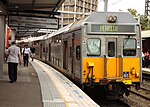
|
160 | 1981–1985 | ||||
| C sets | 
|
56 | 1986–1987 | ||||
| T sets | 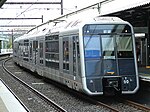
|
447 | 1988–1995 | ||||
| Endeavour railcars | 
|
Diesel multiple unit | 160 | 99 | 28 | 1994–1996 | 2 cars |
| M sets | 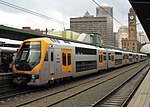
|
Electric multiple unit | 130 | 81 | 140 | 2002–2005 | 4 cars |
| Hunter railcars | 
|
Diesel multiple unit | 160 | 99 | 14 | 2006–2007 | 2 cars |
| H sets | 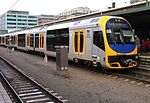
|
Electric multiple unit | 130 | 81 | 220 | 2006–2012 | 4 cars |
| A sets | 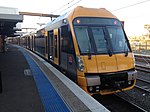
|
Electric multiple unit | 130 | 81 | 626 | 2011–2014 | 8 cars |
Former fleet
The following table consists of trains that were in the CityRail fleet which were withdrawn prior to CityRail's demise:
| Type | Image | In service | Notes |
|---|---|---|---|
| Standard suburban carriage stock | 
|
1925–1992 | Also known as Red Rattlers. Several preserved. |
| Tulloch suburban carriage stock | 1940–1992 | Also known as Red Rattlers. Several preserved. | |
| Sputnik suburban carriage stock | 
|
1957–1993 | Also known as Red Rattlers or Sputniks. Several preserved. |
| 900/800 class railcar | 
|
1951–1994 | Several preserved. |
| U set | 
|
1958–1996 | Also known as U-Boats. Several preserved. |
| Tulloch double deck carriage stock | 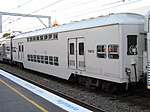
|
1964–2004 | Operated with single and double-deck power cars. Several preserved. |
| 620/720 class railcar | 
|
1961–2007 | Several preserved. |
| 422 Class | 1969/70–1994 (passenger service) | Several in freight operation, several scrapped. | |
| 44 Class | 1957–1994 (passenger service) | Several in operation, several scrapped, several preserved | |
| RUB type carriage stock | 
|
1949–1994 (CityRail service) | Several scrapped, several preserved |
The CityRail network was divided into three sectors, based around three maintenance depots. EMU trainsets were identified by target plates, which are exhibited on the front lower nearside of driving carriages. Target designations and set numbers were used in identifying EMU trainsets. The composition and formations of trainsets, and the target designations were subject to alteration.
| Sector # | Depot | Serviced lines | Target plate |
|---|---|---|---|
| 1 | Mortdale | Eastern Suburbs & Illawarra and South Coast | Red |
| 2 | Flemington | Airport & East Hills, Bankstown, Carlingford, Cumberland, Inner West, Olympic Park and South | Blue |
| 3 | Hornsby | North Shore, Northern, Western, Central Coast and Blue Mountains | Black |
All V sets which operated on the Newcastle and Blue Mountains lines, were serviced at Flemington Depot. All M and H sets, which had a green target plate, were serviced at Eveleigh Maintenance Centre.
Ticketing
For most of the brand's life CityRail's ticketing system was the Automated Fare Collection System (AFC). Dating from 1992, it was based on magnetic stripe technology and was interoperable with the Sydney Buses and Sydney Ferries systems. In later years the network was incorporated into the MyZone ticketing system, which retained the AFC technology but extended the validity of multi-modal tickets to private buses and light rail.
Unlike the ticketing systems of other cities in Australia, most of CityRail's ticket prices were calculated on the distance travelled, and were proven to be the most expensive tickets of any major city public transport system.
Performance
According to the 2003 Parry Report, "The interaction of metropolitan, suburban, intercity and freight lines and services has resulted in an overly complex system. This complexity has contributed in part to the organisation being widely criticised for poor reliability and safety. CityRail was also enormously expensive."
On-time running improved after new timetables were introduced in 2005 and 2006. The newly introduced timetable increased station dwell and journey times.
In October 2012, a report published by PricewaterhouseCoopers found CityRail performed poorly compared to many metro services from 27 other major world cities. Sydney was ranked as the fourth-worst public train system while being proven to have the most expensive tickets of any major city public transport system.
Patronage
The following table lists patronage figures for the network during the corresponding financial year. Australia's financial years start on 1 July and end on 30 June. Expansions and contractions of the network and major events that affected the number of journeys made are included as notes.
| 1990s | Year | 1991–92 | 1992–93 | 1993–94 | 1994–95 | 1995–96 | 1996–97 | 1997–98 | 1998–99 | 1999–00 | |||
|---|---|---|---|---|---|---|---|---|---|---|---|---|---|
| Patronage (millions) |
243.8 | 229.8 | 234.8 | 249.6 | 256.4 |
264.7 |
266.5 |
270.5 | 278.7 | ||||
| Reference | |||||||||||||
| 2000s | Year | 2000–01 | 2001–02 | 2002–03 | 2003–04 | 2004–05 | 2005–06 | 2006–07 | 2007–08 | 2008–09 | 2009–10 | ||
| Patronage (millions) |
302.6 |
276.4 | 273.4 | 273.3 | 270.3 | 273.7 | 281.5 | 296.1 | 292.2 |
289.1 | |||
| Reference | |||||||||||||
| 2010s | Year | 2010–11 | 2011–12 | 2012–13 | |||||||||
| Patronage (millions) |
294.5 | 304.2 | 306.2 | ||||||||||
| Reference | |||||||||||||
| |||||||||||||
- Pippita services ceased in October 1995
- Cumberland Line services introduced in November 1996
- Olympic Park railway line opened in March 1998
- Airport railway line opened in May 2000
- Sydney Olympic and Paralympic games held in September and October 2000
- Epping to Chatswood railway line opened in February 2009
- Bathurst services introduced in October 2012
Network
CityRail operated eleven suburban lines, four intercity services, one regional service, and five connecting bus services, plus a late night bus service across metropolitan Sydney.
Suburban lines

| Line colour and name | Between | Train Types | |
|---|---|---|---|
| Airport & East Hills Line | City Circle and Macarthur via either Sydenham (peak) or Airport | S, K, C, M & T sets | |
| Bankstown Line | City Circle and Liverpool or Lidcombe, via Bankstown | S, K, C, M & T sets | |
| Carlingford Line | Clyde and Carlingford, with limited services to Lidcombe and Central (i) | S, K, C, M & T sets | |
| Cumberland Line | Blacktown and Campbelltown | S, K, C, M & T sets | |
| Eastern Suburbs & Illawarra Line | Bondi Junction and Waterfall or Cronulla | T, S, K & C set | |
| Inner West Line | City Circle and Bankstown or Liverpool (peak), via Regents Park | S, K, C, M & T sets | |
| Northern Line | Epping and Hornsby via Strathfield, Central and Macquarie Park | S, K, C & T set | |
| North Shore Line | Central and Berowra via Gordon | S, K, C & T set | |
| Olympic Park Line | Lidcombe and Olympic Park. Some services operated between Central (i) and Olympic Park, particularly during special events | S, K, C, M & T sets | |
| South Line | City Circle and Campbelltown, via Granville | S, K, C, M & T sets | |
| Western Line | Central and Emu Plains or Richmond via Parramatta | S, K, C & T set | |
:*In peak hour on the North Shore Line, some outer-suburban services run to Gosford and Wyong, and some Western Line services extended to Springwood.
:*Inbound Inner West and South services generally travelled around the City Circle in the clockwise direction. Inbound Airport & East Hills and Bankstown services generally travelled around the City Circle in the anti-clockwise direction.
*Central (i) is a standard abbreviation used on timetables and station screens. It signifies Central's country and intercity platforms .
Intercity lines
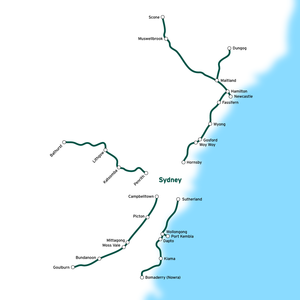
| Line colour and name | Between | Train Types | |
|---|---|---|---|
| Blue Mountains Line | Central and Lithgow, with limited services to Bathurst | V set, Explorer | |
| Newcastle & Central Coast Line | Central and Newcastle | G, H & V set | |
| South Coast Line | Central and Bomaderry or Port Kembla | T, G, H & V set | |
| Southern Highlands Line | Campbelltown and Moss Vale, with limited services to Goulburn | Explorer | |
- ^a Some peak services on the Blue Mountains Line ran to/from Hornsby
- ^b Some peak services and most weekend services on the South Coast Line ran to/from Bondi Junction
- ^c Some peak services on the Southern Highlands Line to/from Central. At other times, a change of train was required at Campbelltown or Macarthur
Regional line
| Line colour and name | Between | Train Types | |
|---|---|---|---|
| Hunter Line | Newcastle and Telarah, with limited services to Dungog or Scone | 620/720 railcars & J set | |
Connecting bus services
CityRail operated several bus routes along corridors where the railway line has been closed to passengers or as a supplement to rail services. These bus services appeared in CityRail timetables and accepted CityRail tickets, but were operated by private sector bus companies contracted by CityRail. Two were CountryLink services that carried CityRail passengers.
| Colour | Connecting line | Between |
|---|---|---|
| Blue Mountains Line | Lithgow to Bathurst via Mount Lambie | |
| Newcastle & Central Coast Line | Fassifern to Toronto via Blackalls Park | |
| South Coast Line | Wollongong to Moss Vale/Bundanoon via Robertson | |
| Southern Highlands Line | Moss Vale to Goulburn via Marulan | |
| Southern Highlands Line | Picton to Bowral via Thirlmere on weekdays only (replaces the closed Picton-Mittagong loop line) |
- ^(r) CountryLink services, seat reservations required
NightRide
Main article: Nightride (bus service)To provide a passenger service between midnight and 05:00 while leaving the tracks clear of trains for maintenance work, parallel bus services were established in 1989. NightRide services operated typically at hourly intervals (some routes depart more frequently on weekends). NightRide services were run by private bus operators, and identified by route numbers beginning with "N". All valid CityRail tickets for a destination (apart from single tickets) were accepted on NightRide services.
Network overview

Most Intercity trains terminated at Central while most suburban (except Carlingford Line) services proceeded through the city.
CityRail also operated several Intercity services that terminate at Central station (though some services operated in the metro-style portions of the system in the peak hours). These lines stretched over 200 kilometres from Sydney, as far north as Newcastle, as far west as Bathurst, as far south-west as Goulburn and as far south as Kiama and Port Kembla. Southern Highlands trains required a connection at Campbelltown as they ran into the city during peak hours only.
Regional services operated from the terminus station at Newcastle, with local electric services to the Central Coast and diesel services to Telarah with some extending to Dungog and Scone. Diesel services also operated on the South Coast Line between Kiama and Bomaderry.
The hub of the CityRail system was Central station, where most lines started and ended. Trains coming from the Airport & East Hills Line and Bankstown Line, after travelling anti-clockwise on the City Circle, sometimes terminated upon arrival at Central and proceeded to the Macdonaldtown turnback. However, most trains continued on and become outward bound Inner West Line and South Line services. The reverse applied for trains coming from the Inner West and South lines, which, if not terminating, became outward bound trains on the Airport & East Hills and Bankstown lines respectively. In the same manner, all trains from the Western Line and Northern Line became North Shore Line trains once they reached Central.
As well as the Intercity services mentioned above, local services also ran in the Newcastle local area during off-peak times, as part of the Newcastle & Central Coast Line. Local services also ran on the South Coast Line in the Wollongong local area, usually between Thirroul and Port Kembla.
Passenger information systems
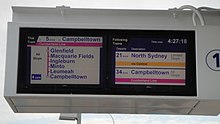
Many CityRail stations were equipped with electronic passenger destination indicator boards. These provided information on the current time, next three available services, time due to arrival, destination route and the number of train carriages available.

Problems playing this file? See media help.
Due to the many differing types of stations that CityRail serves, their screens varied in form. In station where trains arrived at a higher frequency, 2 or more vertical LED screens were used on each platform to display the destination and arrival time whereas in low frequency areas 1 or 2 dual horizontal LED screens with a larger font were used. Manual destination indicator boards were still used at some lower patronage stations. In regional areas, a station relied on digital voice announcement for information on services. CBSM (Custom Built Sheet Metal) was responsible for the manufacture of many indicator board encasings.
Challenges
The quality of the rail system was a matter of considerable political sensitivity. The performance of the State Rail Authority and RailCorp were questioned in regards to safety, training, a politically motivated focus on punctuality, management and workplace culture, with strong criticism from Justice Peter McInerny in his inquiries into the accidents at Glenbrook and Waterfall. Transport is the third largest area of public expenditure in NSW, after health and education. A newspaper distributed to commuters, mX, and the Sydney Morning Herald's "campaign for Sydney" kept transport at the top of the agenda ahead of the 2007 state election. In his 2003 interim report to the NSW Government, Tom Parry was highly critical of CityRail. "It is hard to believe that taxpayers or the state are getting the best possible value from the large amounts of money being spent each year," he wrote.
Safety
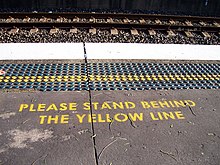
The safety of the CityRail network was called into question by two fatal accidents. The second Glenbrook train disaster in 1999 killed seven people. In 2003, the Waterfall train disaster killed seven. Inquiries were conducted into both accidents. Official findings into the latter accident also blamed an "underdeveloped safety culture." There has been criticism of the way CityRail managed safety issues that arose, resulting in what the NSW Ministry of Transport called "a reactive approach to risk management."
CityRail has launched public information campaigns regarding railway trespassing, prams and strollers, and falling between the platform and the train.
Crime and terrorism
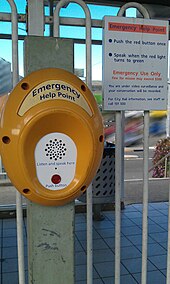
Crime committed on railway property has decreased by 32.9% since 2002, which RailCorp attributes to the deployment of some 600 Transit Officers across the network. All stations, including those that are remote or unstaffed, have emergency "help points" to put passengers in immediate contact with authorities should an incident occur. All stations are covered by closed-circuit television surveillance. However, a large amount of graffiti is still evident on some trains and the depots.
In recent years, concerns over terrorism have played a role in the management of the network. CityRail and other public transport providers participate in an ongoing public terrorism awareness campaign, If you see something, say something, adapted from a similar campaign in New York.
Overloading
In 2008, overloading of trains was found by the Independent Pricing and Regulatory Tribunal (IPART) to be a significant cause of delays. A survey undertaken by RailCorp in September 2011 revealed that 6 of the 13 lines had a maximum load that exceeded 135% (of the seated capacity) during the peak morning commute.
Public perception
One result of CityRail's increasing problems was a sharp rise in public complaints and attacks against staff, with a Boston Consulting Group report claiming staff were actively hiding from irate customers wishing to complain about the service. The highly negative public perception of transit officers acting as ticket inspection officers and charging significant on-the-spot fines has also led to the organisation introducing anti-spitting fines and signage requesting commuters not abuse staff.
See also
References
- Annual Report 30 June 2012 Archived 25 March 2013 at the Wayback Machine RailCorp
- "Opening of the Third Session of the Forty–Ninth Parliament of New South Wales", Hansard: Legislative Council of New South Wales, Parliament of New South Wales, 21 February 1990
- ^ "Steam Workshop :: [AU] New South Wales passenger train logos through history". steamcommunity.com. Archived from the original on 19 September 2020. Retrieved 11 March 2020.
- ^ NSW, Transport for (18 June 2017). "RailCorp". www.transport.nsw.gov.au. Archived from the original on 11 February 2022. Retrieved 11 March 2020.
- Budd, Henry (18 April 2013). "Transport Minister Gladys Berejiklian unveils new transport logo and uniforms". The Daily Telegraph. Retrieved 18 April 2013.
- "U-Boats...A Tribute" Railway Digest November 1996 page 43
- "The Demise of the U Sets" Railway Digest March 1997 page 38
- "CityRail to have Explorers too" Railway Digest May 1992
- "Endeavours Enter Service Only Days After Launch" Railway Digest May 1994
- State Rail Authority (16 November 2000). "1999–2000 Annual Report" (PDF). NSW Government. Archived from the original (PDF) on 21 March 2016. Retrieved 12 April 2016.
- Performance Audit – The Millennium Train Project Archived 22 August 2011 at the Wayback Machine Audit Office of New South Wales June 2003
- "New Hunter railcar goes in to limited service". CityRail. 23 November 2006. Archived from the original on 25 November 2011. Retrieved 31 August 2011.
- "Chatswood to Epping rail line to finally open". ABC News. 30 January 2009. Archived from the original on 13 November 2012. Retrieved 31 August 2011.
- "Epping to Chatswood Rail Link". Railway Technology. Archived from the original on 3 August 2020. Retrieved 11 March 2020.
- Saulwick, Jacob (16 July 2013). "Old trains will stay in service for long after choose-by date". The Sydney Morning Herald. Archived from the original on 30 December 2017. Retrieved 30 December 2017.
- Bathurst to Sydney rail service to benefit Lithgow Archived 21 September 2013 at the Wayback Machine Lithgow Mercury 4 June 2012
- "Train Fleet Maintenance". CityRail. 1 June 2006. Archived from the original on 13 March 2008. Retrieved 18 May 2008.
- Department of Railways, New South Wales: Working of Electric Trains, 1965
- ^ "Transport and Infrastructure better in Mumbai than Sydney:PwC report". The Sydney Morning Herald. 15 October 2012. Archived from the original on 18 February 2013. Retrieved 10 February 2013.
- Ministerial Inquiry into Sustainable Transport in New South Wales Transport NSW December 2003
- "Most CityRail peak-hour trains 'on time'". The Sydney Morning Herald. 12 January 2007. Archived from the original on 8 November 2012. Retrieved 28 August 2011.
- "Wrong side of the tracks". The Sydney Morning Herald. 6 November 2004. Archived from the original on 23 September 2011. Retrieved 28 August 2011.
- "State Rail Authority Annual Report 1996–97" (PDF). State Rail Authority of New South Wales. p. 14. Archived from the original (PDF) on 22 June 2014. Retrieved 3 January 2018.
- ^ "State Rail Authority Annual Report 2001–02" (PDF). State Rail Authority of New South Wales. pp. 10–11. Archived from the original (PDF) on 22 June 2014. Retrieved 3 January 2018.
- "State Rail Authority Annual Report 2003–04" (PDF). State Rail Authority of New South Wales. p. 12. Archived from the original (PDF) on 22 June 2014. Retrieved 3 January 2018.
- "Rail Corporation NSW Annual Report 2007–08" (PDF). Rail Corporation NSW. p. 15. Archived from the original (PDF) on 21 June 2014. Retrieved 3 January 2018.
- ^ "Rail Corporation NSW Annual Report 2012–13" (PDF). Rail Corporation NSW. p. 17. Archived from the original (PDF) on 21 June 2014. Retrieved 3 January 2018.
- "Search train timetables". CityRail. Archived from the original on 24 October 2009. Retrieved 2 December 2011.
- "Clients". Archived from the original on 27 August 2011. Retrieved 7 August 2011.
- Special Commission of Inquiry into the Waterfall Rail Accident, Final Report, Volume I, January 2005, The Honourable Peter Aloysius McInerny QC
- Railway Safety: Interlocking and Train Protection, Ian Macfarlane, 2004
- Parry, Tom (9 December 2003). "Ministerial Inquiry into Sustainable Public Transport" (PDF). New South Wales Government. Archived from the original (PDF) on 14 May 2009. Retrieved 30 March 2008.
- Archived at Ghostarchive and the Wayback Machine: "WIN News Illawarra - Waterfall train disaster 10th Anniversary (31/1/2013)". YouTube. 30 January 2013.
- "Training Rules". CityRail. Archived from the original on 19 April 2008. Retrieved 18 May 2008.
- "RailCorp Annual Report 2006–2007" (PDF). RailCorp. 31 October 2007. Archived (PDF) from the original on 9 April 2008. Retrieved 4 March 2008.
- "CityRail: Security: If you see something, say something". RailCorp. Archived from the original on 28 August 2007. Retrieved 14 September 2007.
- "IPART – New South Wales – Australia". Archived from the original on 18 July 2008. Retrieved 31 July 2008.
- "CityRail – Our Performance". CityRail. Archived from the original on 17 March 2012. Retrieved 19 November 2022.
- "CityRail complaints". The Sydney Morning Herald. 10 October 2008. Archived from the original on 13 October 2008. Retrieved 17 November 2009.
- "Fines – CityRail". Archived from the original on 16 August 2009. Retrieved 17 November 2009.
Other references
- RailCorp 2009–2010 Annual Report
- Interim Report of the Ministerial Inquiry into Sustainable Transport in New South Wales
- Details and map of Clearways
- North West Rail Link
- South West Rail Link
- Christie Report – Long Term Strategic Plan for Rail.
- NSW Audit Office: Managing Disruption to CityRail services.
Further reading
- "Last 'OSCAR' delivered for New South Wales". The Railway Magazine. Vol. 159, no. 1345. Horncastle: Mortons Media Group. May 2013. p. 100. ISSN 0033-8923. OCLC 750645684.
| By state/territory |  | |
|---|---|---|
| By capital | ||
| Stations | ||
| Related articles | ||
| Public transport in Sydney | |||||||||||
|---|---|---|---|---|---|---|---|---|---|---|---|
| |||||||||||
| |||||||||||
| |||||||||||
| |||||||||||
| |||||||||||
| Other | |||||||||||
| Italics denotes services yet to commence | |||||||||||